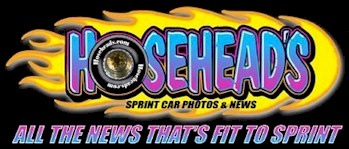|
Here is the article...
By Mark YostRossburg, Ohio
If you’re one of those people who can’t imagine sitting for hours watching race cars go around in circles, then you need to come and sit by the third turn at Eldora Speedway.
There are a lot of great half-mile ovals around the country, but this one, cut out of cornfields on the Indiana-Ohio border, is something special. It is the equivalent of Daytona, Indianapolis and Le Mans all rolled into one. And the King’s Royal, which took place July 17 and 18, is one of its premier events.
At just 40 laps, the King’s Royal used to be the richest sprint-car race in the country. Its $50,000 purse is no longer the biggest, but it’s still the race that drivers most want to win. They race World of Outlaws winged sprint cars, 1,375-pound micro machines with 410-cubic-inch engines that crank out nearly 900 horsepower. Averaging 130 miles per hour, it takes them just 13 seconds to complete a lap here.
Nowhere is that speed more palpable than in turn three. The cars come barreling down the back straight and you think they’re going to keep coming right into the grandstands. But then the driver cranks the wheel hard to the left, the back end kicks out, the car slides up the track, finds traction just inches from the concrete retaining wall, and powers through the corner and down the front straight. And it’s all done with good tires, the downforce of the giant wing and a healthy dose of testicular fortitude.
“I was scared to death when I first came here,” said Nascar star Tony Stewart, who cut his teeth running tough half-mile ovals like Eldora.
Today, Mr. Stewart owns Eldora Speedway. He bought the track in 2004 from Earl Baltes, who built it in 1954. Mr. Baltes is a legend in racing circles for creating the King’s Royal, an over-the-top event that sees the winner don a red velvet robe and gold crown, sit on a massive throne, flanked by a court of nubile trophy queens, and bless the crowd with his scepter.
Since taking over, Mr. Stewart has made only modest changes. He put in billboards (some featuring his Nascar sponsors), built a two-story tower of suites in turns three and four, updated the fence that keeps cars from flying into the stands, and added new lighting.
“I understand that it’s not just the history of this place, but the character,” he said.
So the concession stand still serves its signature pizza burger ($2.50). Cokes are $1. Programs are $3. Parking is free. Camping for the entire week is $35. The main grandstand still has its overhanging roof and full bar. Eldora is thriving.
In fact, many of the short tracks around the country are doing well. That’s because there historically has been an inverse relationship between local race tracks and the economy. When the economy is doing well, fans have more money to go to big races such as the Indianapolis 500. When the economy is bad, fans tend to stay closer to home and support tracks like Eldora.
“During the Great Depression, two businesses did well,” said auto-racing columnist Chris Economaki. “Movie theaters and race tracks.”
“Dirt tracks don’t see the high highs and low lows of the economy,” said Eldora’s general manager, Larry Kemp.
Even Nascar, which has seen attendance at its premier Sprint Cup Series races drop by as much as 20%, is seeing growth at the 58 short tracks around the country where the participants in its Whelen All-American Series compete.
“I don’t want to paint an overly rosy picture, but what I’m seeing is good crowds, good car counts and fan enthusiasm,” said Nascar’s George Silbermann.
That was certainly the case at Eldora.
More than 80 cars filled the pits and 20,000 fans packed the stands both nights. Friday night featured a number of qualifying races and the Knight Before the King’s Royal race. Warm-ups started about 6 p.m. and winner Terry McCarl didn’t take the checkered flag until nearly midnight. For four hours of adrenaline-pumping entertainment, fans paid $25. A grandstand ticket to see sprint-car superstar Donny Schatz win his second King’s Royal on Saturday night cost $32.
In addition to being great racing, events like the King’s Royal are a slice of Americana that’s disappearing. The local Veterans of Foreign Wars and volunteer fire departments schedule pork-chop dinners and pancake breakfasts. After the races, fans pack local hole-in-the-wall bars such as the St. Henry Nightclub, whose sign simply reads: “Liquor-Beer-Eats.”
The fans are about as blue-collar as they get. I didn’t see a single pair of pressed khakis or a polo shirt all weekend. The uniform of the day was blue jeans and a T-shirt featuring a favorite driver. Veteran fans who sit in the corners know to wear hats and goggles to protect themselves from the dirt cloud that’s kicked up as cars go screaming by.
As impressed as I was with the King’s Royal, noted auto-racing writer Dave Argabright told me I should come back in September for the World 100, which features late-model stock cars.
I think I’ll take that advice.
|
